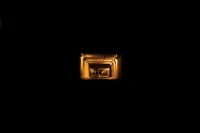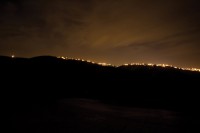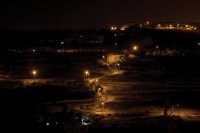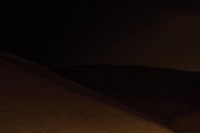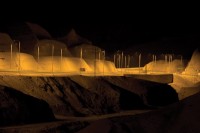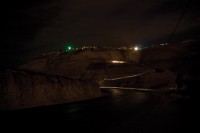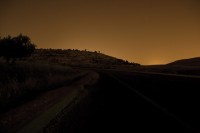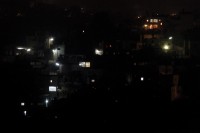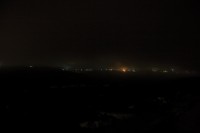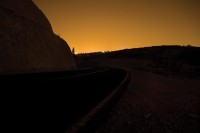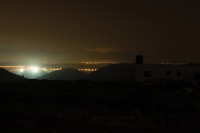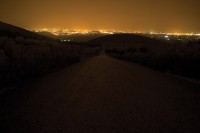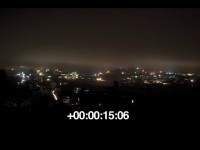Landscape of Darkness (2010)
Photography and Video
In the spring of 2002, during the massive Israeli incursions into West Bank cities, my friend Mohannad and I were stuck in the town of Birzeit for several weeks under an ‘easy’ curfew. At 3am one morning, restless from the crushing boredom and power outages, we decided to go for a walk to a nearby hill. It was so dark that we could barely see ahead of us and though walking slowly, we kept falling but thanks to the power of boredom we reached the top of that hill.
And there it was. Right there in that total darkness, shining like a diamond that had just landed on earth was the city, the coastline: Yaffa. There was nothing between us except the vast darkness.
Mohannad looked at me and said, “Oh my God, I never knew it was this close”. “I’ve never been there…” I answered, not taking my eyes off it. Without much talk we set off, heading towards it. So close, we were convinced it would only take us a few hours to reach. We walked and walked, and as we walked, the first smear of dawn was already bleaching the rim of the Mediterranean sky. The more the skies lit up, the more the city slowly moved away from us until finally, it completely vanished into the light.
At that instant of the city vanishing into light, darkness declared itself a landscape. Darkness that in one glimpse brought this fragmented land together, smoothed it and served as a platform where exiled space could be reclaimed and a narrative of a continuous space constructed.
Produced with the support of
AFAC, YATF, Mawred
Exhibition:
Deep Into the Darkness Peering, Khalil Sakakini Cultural Centre, curated by Lara Khaldi, Ramallah 2013
Worlds, curated by Pier Luigi Tazzi, Gallery die Mauer, Prato 2012
Landscape of Darkness, Transit Gallery, Mechelen 2011
Texts:
ArtAsiaPacific, by HG MASTERS, 2011
Photography in Vanishing Landscape, by Nayrouz abu Hatoum, 2013
Darkness Against Landscape, is the thesis i wrote in relation to this project for my MA at Goldsmiths Collage. here
Darkness Against Landscape @ Kalamon (in arabic) here
______
Other Texts on Landscape of Darkness
Memory of Light and Darkness
Reem Fadda
The recording of space, the making of geographies and ones memories of place are all foundational components from which ideas of belonging are constructed and creation of nationalisms facilitated. Historical narratives of countries are made through understandings of spatiality. Collective renderings of space make for collective belonging. When that is lost, when the Diasporic is all that remains, what can be depicted?
It is quite compelling to see the radical military procedures happening on a daily basis that directly affect the Palestinian experience of place. Israeli military practices result in a fragmentation of the Palestinian concept of continuous geography and time. There seems to be an arbitrary military scheme unfolding that affects Palestinian territoriality and creates urban disjuncture. However, these seemingly ad-hoc actions are very much non-arbitrary and not only do they aim at creating discontinuity in the terrain and hence an impossibility of a viable contiguous Palestinian state, but more dangerously they fragment the possibility of a collective making of history in the Palestinian national sense.
History is a maker of national consciousness. This is not to be confused with the imaginary of the collective. When history cannot be amalgamated then the national consciousness suffers. Imagine when the urbanity of a landscape is mutilated to a point of no wholesome recognition and no possible imagination of continuity of geography. This is compounded when the urban and geographical experience of one person differs from his/her neighbour drastically. Take for example the Israeli Allenby Bridge, a crossing point enforced on Palestinians who wish to travel abroad. The military procedures there change, sometimes drastically and sometimes subtly, to the point where the possibility of collective recognition is removed. Accounts of the hours spent waiting in line or the particular processes of security scanning differ from time-to-time and person-to-person. The Israeli soldiers always relegate these extreme inconsistencies to ‘security reasons’ but this security rationale is designed to erase collective memory. It creates a state of constant uncertainty and removes historical coherence from any prospect of national imaginary. This is not to mention the hundreds of “flying” checkpoints scattered throughout the West Bank and Gaza Strip or the permanent checkpoints that seem always to be in constant physical permutation. Through a long and subtle conversion, Qalandia checkpoint, which lies between the border crossing of the adjacent cities of Ramallah and Jerusalem, has transformed from being a post to a barracks to a terminal, in a count of a few years.
Therefore, these constant changes afflicting the landscape are not only purposeful but directly affect the Palestinian experience of their time and space. Historical and geographical imaginings are discontinued. There becomes a fragmented awareness in terms of space and time on the minutest of scales. What one person imagines of the geography or contemporary history of Palestine differs drastically from the other. How you experience the checkpoint differs from that of your neighbours in daily circumstantial, seemingly random happenings. The collective form of national consciousness is infinitely fragmented – Palestinians are not only a Diaspora in the outer world, but this becomes also reflected within. Palestinians have no room for the makings of a ‘shared’ past within this reality. And this continuous radical forced rupture with the past transforms it into an obsession with timelessness: contemporaneity is heightened and the only focus becomes daily survival and not an interrogation of history and its relation to national projects.
It is important to remember that the Palestinian relationship with time is severed on a daily basis so it is characteristically a forceful relationship. The violence of these ruptures reiterates the need for stratagems to deal with this exceptional reality of time and the need to assert history makes it ever a more political act. However, amidst this chaotic relationship with the past and the constant fight to emphasize history, a new opportunity arises. The opportunity is to reconfigure time and consciousness in a way that does not seek to be merely reactionary or responsive but responsible to the creation of new formulas for the interpretation of this modernity. A new interpretation of time creates loopholes to capture agency.
--
Yazan Khalili avidly captured photos of the area designated ‘C’ [Israel Controlled West Bank] in the Palestinian territories. He did so from the vantage point of bypass roads that connect the various Israeli settlements and shadow the Palestinian villages and towns. However, he worked in the dark. Khalili chose the mask of darkness to reveal random layers of light. Cityscapes appear only when there is light. Although it seems the imbalance of power and representation unravels itself with the light that is not the intended reasoning behind the artist’s work.
Khalili invites us into the layers of darkness, because the darkness becomes a symbolic shroud. Darkness that envelops the landscape stands for something in relation to our spatial consciousness. He works in darkness to invoke the use of memory and imagination. How else can a disjunctive space connect? How else do we remember our surroundings? How do we amalgamate those shredded lines and uneven terrains of lived land? These bowels of darkness seem to be not only a reminder of the misery of the political circumstances, but also an allusion to the depth of forgetfulness of what coherent spatial consciousness looks like. Be it for Palestine or Israel. Very much like those lines of light he depicts so intelligently, the demarcations are blurred. He tries to capture light that shows difference with no prejudice but still Khalili focuses on the darkness in the midst.
Khalili also searches for the particular space in this spot of land where the Diaspora is most manifest: land in loss. This ‘C’, this third zone is created by political realities that have left the space in a state of confusion. The artist treads these roads literally, as if embodying the refugee, searching for meaning in a landscape that has no definition. How much of that loss becomes significant to identity politics, personal confusion and dissolution of nationalistic agendas? The abyss of darkness is an indication of all that, yet the lights complicate the narrative. They are not linear and certainly not continuous.
Taking a photograph in darkness is one of the ultimate challenges for a photographer. How much light do you need to make a picture in total darkness? The challenge is exacerbated when the search for light is literally while moving on the road (a hazardous road as well). As an indicator of the importance of the process of this search for light, the artist does away with titles in the photos on display in this book. The only signifiers are the shutter speed and exposure time. In highlighting the measures and the processes of the search and its depiction, the work becomes a quest, a fairytale of sorts. For this light is the fix/ture. Or is it the memory that will conjure the way out?
Memory is an important component that seems tied to the polarities at hand. Memory is attached to the process of depicting light. It is an amalgamation project. It is used here to give coherence to a visual narrative that has long been disjoined. Yes, memory is also a fixer. Capturing the memory is what a cultural agent does in exposing historical truths amidst conditions of conflict. Khalili does this not in the fleeting documentary sense, but rendered in the highest poetic form possible. He uses memory to allude to historical fixture.
In his previous work “Colour Correction”, Khalili tried to provide another ‘fix’ for the urban realities in the Palestinian context. In a series of photographs, he depicted the angularities of various refugee camps in Palestine, focusing on their urban manifestations and conditions. However, he applied the imaginary by using Photoshop to colour the refugees’ houses in various pastel shades making them more visually prevalent. They stand out from being only waves in a concrete mass. He sheds colour to make them more visible.
Khalili does the same in the current photographs. He uses again the power of the imaginary but without the power of colour. The equation of light, darkness and memory leads naturally to the conclusion of the imaginary. What do we imagine the lights stand for? What symbolism do they hold forth? What realities do they represent and how can these realities change? These are just a few questions that are left with the beholder.
The display of light in this assemblage of photos by Khalili has many allusions. It manages to evoke nostalgia or a sense of romanticism, a reminder of twilight nights, candles, power cuts, solitude and calmness. Yet somehow the knowledge of the unevenness in the surrounding layout causes a jolt to the senses or an ever-creeping eeriness and unease. From the soothing effect of light, we find a spectrum of disturbance also perceived in light. The villages are physically separated in the rendition of light, from the somewhat forced lines of light emitting from the settlements. Cultural and urban difference and tensions are pulled ajar. How does this same light become so disquieting and unnerving? It is both a tool and a mirror; passive, aggressive and yet active. Provocateur and redeemer all at once.
Amidst the quiet chaos of territories in shambles, there is a conciliatory attempt in the search for light that crystallizes understanding. The attempt to find light becomes a rendition to find coherence, be it in the national narrative or towards the continuation of geography. What it really does, however, is stand as a witness to complex realities, a witness that slowly metamorphizes into an agent of change just as light does when you switch it on.
______
Salvation in Darkness
Adania Shibli
Sometimes a few dots of light are scattered in darkness and sometimes thick consecutive dots of light push darkness as far away as possible. These are the two landscapes that Yazan Khalili presents in his collection “Landscape of Darkness.”
In the photos dominated by darkness, which are numerous, here a light emerges from the ground floor of a building at the bottom right of the photo, or there a light in the center emits from a balcony, while tens of windows are in darkness. These photos, despite how little appears in them at first sight, reveal the infinite possibilities of change in the photographed landscape. For at any moment, a room or a balcony may be lit when a mother of a teenager gets up late at night to see if her son came back, when somebody wants to go to the toilet or to drink, or is suffering insomnia and finally gives up all attempts at pretending being asleep. The number of possibilities for the landscape to change following the sudden emission of light here or there, for one reason or another, are at least as many as the number of dark windows and balconies in the photo.
These photos of light and darkness do not only depict the landscape at the moment of being photographed, but also they depict the extension of its existence in other unphotographed moments; some of which have passed and others which haven’t yet. As such, despite their being photographs, they are “moving pictures.”
Opposite to these semi-dark photos, the collection includes some that are less dark and dominated by thick, consecutive light dots. Here, the majority of the lamps, if not all, seem to be lit. The almost orderly distribution of the points of light suggests that they have not been lit individually, at different times and by different persons. Rather, they all have been lit at the same time by a central lighting unit, and it seems they will be switched off together in the same way after the disappearance of darkness. There is little possibility that a lamp will suddenly be lit, or another suddenly switched off, of course unless something is wrong with it. So these photographs - as opposed to the ones with the few dots of light randomly scattered - do not reveal infinite possibilities of change that might occur in the landscape they depict. Therefore, it may be said that these photographs, as a result of the landscape they depict, remain “still” in the full sense of the word.
Nevertheless, the difference between the two types of landscape in the photos is not exclusive to what the camera depicts and how light dots diffuse inside the frame, but also in how the camera does this and specifically from what distance.
The camera depicts the landscapes of darkness penetrated by a few lights randomly scattered, from amid fields or from inside residential areas; among houses or above streets. One can actually notice the gradual entry of the camera into this semi-dark landscape through the changing distances from/at which it appears. One can also notice that the photos are of a Palestinian area. This can be guessed by the olive trees, the architecture of buildings and their distances from each other and the gardens that connect them.
In addition, it seems, the camera moves freely within the Palestinian area or space as it is able to explore its dimensions from different points, and if a thread were stretched between them it would be possible to measure the depth of this space and even form a three-dimensional shape, reflecting its real features.
This is different from the photos in which the darkness is penetrated by orderly thick lights. In these photos, the camera depicts the landscape from points much further away than is the case in the previous ones. The camera does this from inside darkness and sometimes from above the road leading to that space or even from inside the Palestinian space, whereby both types of landscape appear together in the same photo. Still, the camera in all these photos remains outside the thickly lit space. It does not enter it, even once, as if it is prohibited from entering or even approaching. It only peeps at it from afar; for this is actually an Israeli area.
But from such faraway points of depiction, the landscape of the Israeli area, which is depicted in this case by a Palestinian prohibited from approaching it or entering and moving inside it, is transformed into a two-dimensional sight, rather than being a three-dimensional site; a sight to be presented and not a site to be present in, in comparison with the Palestinian area.
Finally, it seems that darkness does not only distinguish the Palestinian space from the Israeli one, but it also symbolizes the space of free movement for a Palestinian. Meanwhile, the thick light does just the opposite: it restricts and hinders such movement. By preventing and attempting to hinder darkness, the Israeli space attempts to keep the Palestinians away from it and to protect itself from them by light.
This equation of light and darkness – light as a restriction of free movement and darkness as its permission - and what it means to a Palestinian, including the photographer himself, Yazan Khalili, is acutely reflected in one photo, the photo of the lit tunnel surrounded by absolute darkness.
Here one may recall the famous saying ‘light at the end of the tunnel’, as an expression of approaching salvation, in which the tunnel’s darkness is the source of trouble while light is relief. But as this specific photo suggests, just the opposite might be said with regard to a Palestinian. Here it can be said that one yearns for the darkness at the end of the tunnel so as to achieve freedom and salvation.
Margin
The presentation of the Palestinian space in this case, in fact repeats what Bryson notes on the visible invisibility, or the emptiness inside a picture in his text ‘The Gaze in the Expanded Field’. Drawing on the notion of ‘sunyata’, meaning emptiness, or blankness, which was introduced by Japanese existential philosopher Keiji Nishitani (1900-1990), Bryson re-examines the role of invisibility, or ‘emptiness’ in an image.
If the object is, say, a flower, its existence is only as a phase of incremental transformation between seed and dust…: at no point does the object come under arrest that would immobilize it as Form… Moved on the field of sunyata or radical impermanence, the entity comes apart. It cannot be said to occupy a single location, since its locus is always the universal field of transformation: it cannot achieve separation from that field or acquire any kind of bounded outline. (Bryson 1988, p. 98)
So by passing to the field of the visible, the sunyata, as emptiness or blankness, opens up the image so as to include that which is the effect of exclusion - the invisible. Bryson thus goes on to argue:
From this point on, only a technique which undermines the frame can stand in for the invisible which the frame excludes. And if we try to picture to ourselves the gaze of the sunyata or blankness, it must be in terms of the nonrepresentational or the anti-representational. (Bryson 1988, p. 101)
In fact Bryson finds an illustration of this visual order in the Japanese technique of painting, the ‘flung ink,’ where the ink flies out and leaves parts of the painting empty. The flung ink method includes a reference to that which is left outside the frame; the invisible, or the non-representational.
To Bryson, by including the nonrepresentational or the anti-representational, ‘the image is made to float on the forces which lie outside the frame’, or ‘what breaks into image is the rest of the universe, everything outside of the frame’, that is the invisible. (Bryson 1988, p. 103)
______
Inversion of Light & Dark
By Yazid Anani
We have all been educated since our childhood to construct a collective imaginary about darkness and light with all that the two terms hold from biblical and popular connotations. This is fed by a supporting and prevailing representation provided by a cultural and entertainment industry through television shows and movies that add to the association of diabolism with darkness and divinity with light. It seems that when the darkness removes visual streaming from our surrounding environment, the mind disfigures our perception of what would or could happen. Maybe, this is why we fear darkness and we relentlessly tend to relate it to evil. This is a sort of violence towards what we cannot comprehend with our human senses and logic. Hence, the way we have dealt with the unexplainable historically is either by collective violence like burning women in the middle ages for witchcraft, or by forging fictional systems of belief to which we contemplate and attach all unexplainables. Therefore the association that light is divine and darkness is demonic is very much debatable.
Light is an oppressive element and darkness is refuge and safety. This is the landscape of being under occupation in the West Bank that I personally experience while travelling through the geography of the West Bank at night. The dark landscape becomes a haven in the visual struggle of power and resistance, fear and security, organity and military-order, helplessness and restriction. The fact that light is a costly service and is paid for leads to an interpretation of the landscape at night as showing only what is important and worth illuminating and spending money on. Therefore, all details that might be distracting are enveloped with darkness leaving a dialogue between lights. Travelling with different friends and visitors from Ramallah to Beit Sahour to visit Sandi and Alessandro was always an opportunity to explore the territorial dichotomy of light and dark.
On the way back from Beit Sahour to Ramallah, the night also makes obvious that most of the settlements mount the tops of mountains and hills, in particular those terrains that provide 360? of visual exposure – a panopticon - to the urban and rural landscape of the occupied territories. The orderly system of light in settlements with their floods of orange coloured light covering the whole colonial location defies in rivalry and dominion those bluish and whitish, organically dispersed lights of Palestinian built-up areas. Watching from the landscape of darkness, tentacles of dotted lines of lights denote the arteries of settlements which are known as bypass roads. Many of these are banned to Palestinian traffic and thus designated only for the mobility of the other: the gods of light in the occupied dark landscape. The Palestinian roads by contrast are invisible, as if mobility at night ceases to exist or prefers to be wrapped secretly with darkness. The sight of a settlement floating over an empty area of orange light, created by the floodlights that maintain night time security of the settlement, is mesmerizing. This light is evil. It warns Palestinian that any step in that area of light means exposure and means the defences of the settlement are activated. It means shooting from watchtowers and it means army vehicles appearing immediately out of nowhere. You can’t see the physical barriers of barbed wire fences around the settlements at night, they’re not important. The light is the non-physical barrier; the light is the cheapest psychological defence that terrorizes the mind and controls mass behaviour.
Palestinian roads and lands are enveloped with darkness. The constellation of light is always a territorial demarcation between what is colonial and what is local in dark landscape. When you see a small oasis of light while driving along in darkness you realize immediately it’s a checkpoint; a permanent one. Cars line up in the dark exposed by both red brake lights and white headlights waiting to cross to the area of orange light - the checkpoint. Suddenly the cars’ lights are turned off one by one, shimmering at the same spot when reaching the parametrical roadblocks of the checkpoint. Those in cars are exposed by the luminous floodlights, blinded by their intensity. The only thing one can see is the silhouettes of the soldiers ahead which suddenly disappear when cars from the opposite side cross the checkpoint and turn their lights on, increasing the intensity of light and blinding those who are waiting for a signal from the soldier. It is confusing. You cannot know if the silhouettes are signalling for you to advance or not. If you move without being signalled to there is punishment. Is not this colonial light oppressive? Although it’s translucent and attracts beautiful moths at dark, it imbues the surrounding environment and landscape with hostility. One is betrayed by one’s own landscape when illuminated in the dark.
Sometimes I wonder if we fear the dark landscape of the West Bank and its obvious power manifesto represented through light. I wonder if this painful reality of dark and light is feeding our learned helplessness and forcing us psychologically to sustain our imprisonment in our cantonized geography when the dark falls. Passing through the different villages on the road, the lights are friendly, maybe because of the familiarity of the place to me or maybe because of the insignificance of light not used as a means of control or oppression. Light is used sometimes to signify social status and wealth. In some of these villages you frequently see big villas built by those Palestinians who were forced or chose to leave the country in, or before, 1967 and went to the United States or southern American countries such as Brazil and Chile. These villas at night look like a circus of lights especially the rooftops, the garden and the long lane that leads to the entrance. They look like glittering alien objects in the village landscape with its more subtle, modest light.
You begin to feel a sort of analogy in terms of the scheme of light in settlements when you reach your destination and enter the city of Al-Bireh. The main road is lit with the same order and principle like that of a bypass road! However, this is more a sign of the neo liberalism and global trends that are affecting the urban transformation of Ramallah and Al-Bireh. It’s paradoxically funny on the other hand when you go back to your flat after the long drive and realize when you put down the shutters of your balcony that the lights of the coast are so clear. It’s Tel Aviv that looks glittering and flamboyant. It looks beautiful. Yet it is a self-reminder of an unreachable landscape and of the white city that indicates the beginnings of occupation. Yet it’s still beautiful.
Nevertheless, when the daylight dominates the whole urban landscape again and details of what was the dark or lit landscape at night are once more visible, one starts wondering about the visual analogy between colonial and local. You wonder a lot about the dominant values and aesthetics of the powerful and their adoption by the powerless. Maybe at night there is an inversion in the meaning of dark and light to Palestinians but in daylight there is an inversion in the meaning of colonial and colonized.
